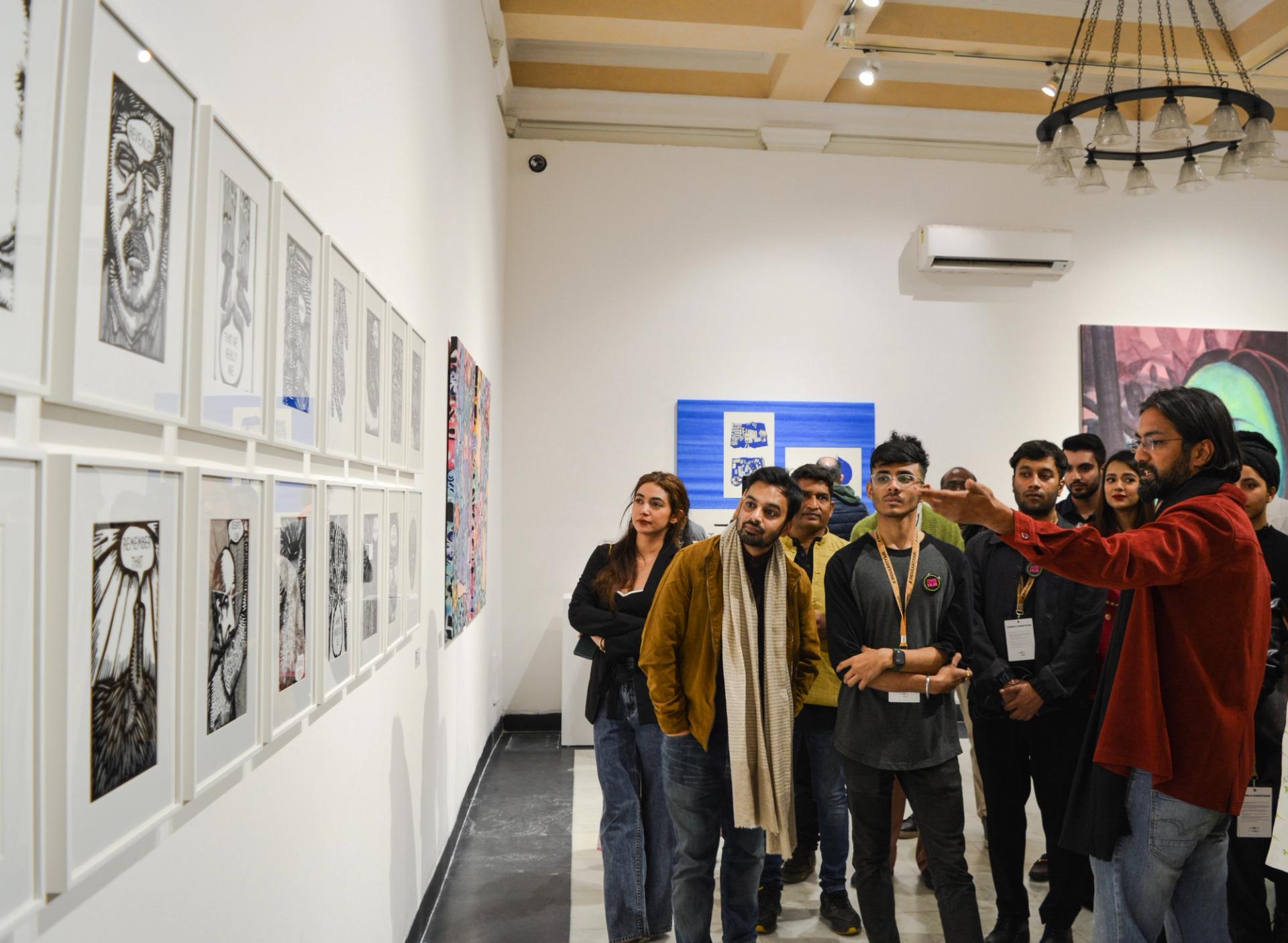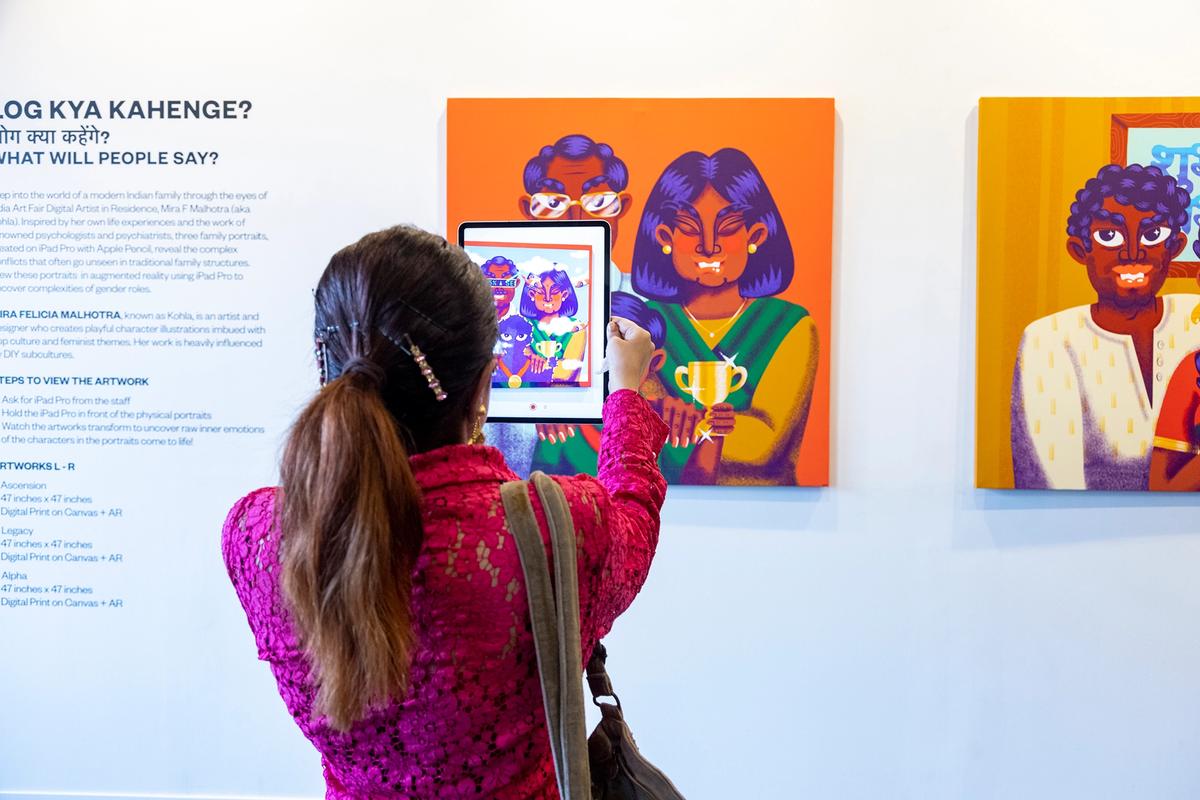It is back to a ‘new normal’ at the 14th edition India Art Fair (IAF, until 12 Feb) in New Delhi, South Asia’s largest commercial art event, for which 71 galleries have gathered in a tent on the National Small Industries Corporation (NSIC) Exhibition Grounds. The first edition in its regular slot following a Covid-delayed April event, the fair benefits from increased international traffic from the Kochi Biennale and Dhaka Art Summit, as well as strong winds having swept away some the city’s notorious winter smog.
This year's iteration—the fair’s largest in terms of participants—is, according to an official statement, the “most ambitious to date”, though not much inside the tent appears to have changed from recent editions: mostly the same contingent of South Asian galleries are selling works primarily, though by no means exclusively, from the subcontinent, with almost no video or digital art on display. Not very much seems to have changed at the very top end of the contemporary art market either, where works by the same select group of artists over the age of 45 are still being offered for high five- and very low six-figure sums.
“I wouldn’t say the market’s top-end is stabilising so much as at risk of stagnating,” says the adviser Priyanshi Saxena. “The pool of major collectors remains very small, while most buyers who are looking for status symbol pieces have already acquired the usual names and aren’t being offered much that is new or envelope-pushing.”
India’s largest contemporary art galleries, which are situated in the front-right of the tent, have staged stands of works with a rough average price of around $20,000, and a typical price range of $3,000 to $150,000. A handful of works above this threshold quickly sold in the first hours of the preview day, including a new painting by Rameshwar Broota at Vadehra Art Gallery from Delhi, which went to a private UK collector for $200,000, and a large glass and brass sculpture by Subodh Gupta at Nature Morte, also from Delhi, for $260,000. The country's most prominent collectors, including Lekha Poddar and Kiran Nadar, were seen buying works at the VIP preview, with the latter’s acquisitions including a 2022 suite of pastel drawings by Sohrab Hura from Experimenter gallery, which has locations in Kolkata and Mumbai.
Speaking to dealers and fair officials, much is being made of India’s new position as the world’s fifth largest economy. But the presence of prestigious international galleries—typically seen as votes of confidence in the region’s market—has dwindled. In past editions, heavyweights such as David Zwirner, neugerriemschneider and White Cube took stands; this year, there are just two: Galleria Continua, which has brought, but not yet confirmed placement of, a 2018 lacquered stainless steel sculpture by Anish Kapoor for $900,000 and Marc Straus, which included on its stand two small paintings of snowscapes by the German painter Ulf Puder—described by one of the gallery’s employees as an “exotic” offering, as Indian buyers “rarely see icebergs”.
“It is because of date clashes,” says Jaya Asokan, the fair’s director since 2021, explaining the lack of international galleries. “The new addition of Art SG Singapore plus Arco in Madrid placed some of our longstanding partners in a tricky spot.”
Nevertheless, according to recent reports, the overall market is seeing record sales figures with those for contemporary art stronger than they were before the pandemic. Asokan, while acknowledging the relative strength of the domestic market, adds that her job is not only to ensure the fair's galleries place big-ticket works, but also that growth occurs across the sector and can be maintained beyond this current generation of collectors. To this end, she says that one of her key initiatives has been to push galleries for increased price transparency to reduce barriers for newer buyers entering the market. In particular, the fair is taking impressive strides to target younger potential collectors for whom the $4,000 to $6,000 price range is "the sweet spot", Asokan says.
This demographic is being courted by a growing number of initiatives taking place in the city this week, such as the Young Collector Weekend (YCW), which stages pop-up selling exhibitions to connect young art buyers with emerging artists. “The buyers I connect with are typically new tech wealth, or married couples who have moved out of their parents’ homes and are looking to do up their own,” says YCW founder and adviser Teesta Bhandare. Some of these artists have formal representation, but Bhandare says her initiative is not antagonistic to the gallery model, and allows dealers to offer more exposure to their roster of artists outside of solo shows and fairs.

Courtesy India Art Fair
The inclination of younger art professionals to rethink traditional industry models is apparent throughout the fair's Young Collectors Programme, now in its fourth year, which aims to harness a wealth of young casual art buyers between their 20s and early 40s, and convert them into serious patrons. The programme centres on a group of selling exhibitions, this year staged at the central New Delhi cultural venue Bikaner House. Prices for works are rarely above $3,000, and range from street art to videos and photographic documentation of performances. Challenging and atypical works proliferate, including an installation of rotting gourds and a found object work that features a functioning receipt-printing machine.
For the second year in a row, the programme has also helped launch a new gallery by supporting and connecting dealers to sponsors and funding. Making its debut this year is XXL, which will next month open an 8,000 sq. ft space in Mumbai. For its first show, it will host a survey show of street art-inspired work. Last year, the same programme launched Method gallery, which maintains two spaces in Mumbai.
Whether these young galleries—neither of which has a permanent roster—are able to foster the careers of artists rather than provide them an occasional sales and exhibition platform, remains to seen. XXL's director, Joe Cyril, says that he is considering establishing a roster once the gallery is a little older, and also collaborating with other dealers overseas.
Further initiatives at the fair include organising patron support for artists, as evidenced this year by Ruchika Sachdeva, who in funded a performance at Bikaner House by the artist Sajan Mani this week, including the cost of materials, transport and an artist fee. “It is important to access creatives from beyond the art world—including music, theatre and fashion. They don't just bring their money, but their communities," says the curator of the Young Collectors Programme Anicka Mann.
This concerted push by the fair appears to be a welcome one, even by market players who have now aged out of the emerging sector. "When I started my gallery, this wasn’t even a conversation to be had," says Hena Kapadia, the founder of TARQ in Mumbai, which opened in 2014. "Not all of these younger buyers will develop into serious collectors—but some will. I began with younger collectors wishing to support artists of their generation—and the prices eventually corrected after a few years."
Naturally, very few younger spaces can be found inside the main art fair, where stand prices are still prohibitively expensive for businesses conducting the bulk of their sales under $5,000. Somewhat of an exception is Chemould CoLab, an extension of Chemould Prescott Road, Mumbai’s oldest gallery, focused on emerging artists. Making its debut this year, it is showing a brightly coloured stand featuring works by four artists under 35-years-old, with prices beginning around $2,000 and not exceeding $10,000.
Nonetheless, promising, new faces can still be found. Showing at IAF for the first time this year is Iram from Ahmedabad in Gujurat, western India—one of a handful of galleries at the fair to have opened in the past five years. Its booth features sculptural work by the only two artists on its roster—Rakesh Patel and Nariyan Sinha. Its director Harshh Shah says he is hoping to slowly build up his list of represented artists in a thoughtful way, benchmarking it to other leading galleries in the subcontinent such as Experimenter. "It is key to develop your programme slowly and not succumb to decorative sensibilities," Shah says. By the end of the preview day, he had not sold any works, but he appeared undeterred: “I understand what the long game here is, I’m willing to wait.”
- India Art Fair, until 12 February, NSIC Exhibition Grounds, New Delhi


